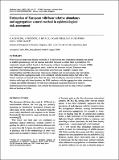Por favor, use este identificador para citar o enlazar a este item:
http://hdl.handle.net/10261/61180COMPARTIR / EXPORTAR:
 SHARE SHARE
 CORE
BASE CORE
BASE
|
|
| Visualizar otros formatos: MARC | Dublin Core | RDF | ORE | MODS | METS | DIDL | DATACITE | |

| Campo DC | Valor | Lengua/Idioma |
|---|---|---|
| dc.contributor.author | Acevedo, Pelayo | - |
| dc.contributor.author | Vicente, Joaquín | - |
| dc.contributor.author | Höfle, Ursula | - |
| dc.contributor.author | Cassinello, Jorge | - |
| dc.contributor.author | Ruiz-Fons, Francisco | - |
| dc.contributor.author | Gortázar, Christian | - |
| dc.date.accessioned | 2012-11-26T17:11:22Z | - |
| dc.date.available | 2012-11-26T17:11:22Z | - |
| dc.date.issued | 2007 | - |
| dc.identifier | doi: 10.1017/S0950268806007059 | - |
| dc.identifier | issn: 0950-2688 | - |
| dc.identifier.citation | Epidemiology and Infection 135: 519- 527 (2007) | - |
| dc.identifier.uri | http://hdl.handle.net/10261/61180 | - |
| dc.description.abstract | Wild boars are important disease reservoirs. It is well known that abundance estimates are needed in wildlife epidemiology, but the expense and effort required to obtain them is prohibitive. We evaluated a simple method based on the frequency of faecal droppings found on transects (FBII), and developed a spatial aggregation index, based on the runs test statistic. Estimates were compared with hunting data, and with porcine circovirus and Aujeszky's disease virus seroprevalences and Mycobacterium tuberculosis complex and Metastrongylus spp. prevalence. The FBII and the aggregation index were correlated with the hunting index, but both of the former estimates correlated better than the latter with the disease prevalences. Hence, at least in habitats with high wild boar densities, the FBII combined with the aggregation index constitutes a cheap and reliable alternative for wild boar abundance estimation that can be used for epidemiological risk assessment, even outside the hunting season and in areas with no available data on hunting activities. © 2006 Cambridge University Press. | - |
| dc.description.sponsorship | The wild boar study was supported by projects AGL2001-3947 and AGL2005-07401, Ministerio de Ciencia y Tecnología and FEDER. A wider study on wildlife TB is supported by INIA, MCYT RTA03- 074, and by Grupo Santander. Census methods and overabundance are addressed in project PREG-05-19, Consejería de Medio Ambiente, JCCM. Jorge Cassinello and Francisco Ruiz-Fons received supported from the Ministerio de Educación y Ciencia, through a Ramón y Cajal contract and a FPU grant,respectively. | - |
| dc.language.iso | eng | - |
| dc.publisher | Cambridge University Press | - |
| dc.rights | openAccess | - |
| dc.title | Estimation of European wild boar relative abundance and aggregation: A novel method in epidemiological risk assessment | - |
| dc.type | artículo | - |
| dc.identifier.doi | 10.1017/S0950268806007059 | - |
| dc.date.updated | 2012-11-26T17:11:23Z | - |
| dc.description.version | Peer Reviewed | - |
| dc.identifier.pmid | 16893488 | - |
| dc.type.coar | http://purl.org/coar/resource_type/c_6501 | es_ES |
| item.cerifentitytype | Publications | - |
| item.openairecristype | http://purl.org/coar/resource_type/c_18cf | - |
| item.grantfulltext | open | - |
| item.openairetype | artículo | - |
| item.fulltext | With Fulltext | - |
| item.languageiso639-1 | en | - |
| Aparece en las colecciones: | (IREC) Artículos | |
Ficheros en este ítem:
| Fichero | Descripción | Tamaño | Formato | |
|---|---|---|---|---|
| Hofle_Epidemiology.pdf | 157,62 kB | Adobe PDF |  Visualizar/Abrir |
CORE Recommender
PubMed Central
Citations
32
checked on 04-may-2024
SCOPUSTM
Citations
171
checked on 29-abr-2024
WEB OF SCIENCETM
Citations
158
checked on 28-feb-2024
Page view(s)
354
checked on 06-may-2024
Download(s)
305
checked on 06-may-2024
Google ScholarTM
Check
Altmetric
Altmetric
Artículos relacionados:
NOTA: Los ítems de Digital.CSIC están protegidos por copyright, con todos los derechos reservados, a menos que se indique lo contrario.
